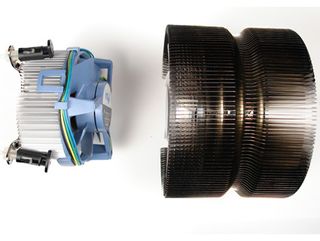Extreme Overclocking
Adequate Cooling, Contiuned

Intel's retail Core 2 Extreme X6800 Conroe cooler vs. Zalman's CNPS9700 NT
More Conventional Means
While we could have pushed the envelope, as we have done in previous overclocking articles, we decided to keep things here within the realm of what most people could get themselves. After all, overclocking can be accomplished with traditional heatsinks and fans.

Now, stock cooling is fine for regular use, but if you want to push components past their specified operating thresholds, you need a better cooling solution. Various designs based on air cooling are in the marketplace, but forced air has its limitations. The Zalman CNPS9700 NT shown above represents the typical progression in the quest for better air cooling. As microprocessors shrink in size, the surface area to remove heat caused from internal electrical resistance drops as well. Thus, heat pipes have been added to move energy away from the die, out to fins with greater surface area, which allows air molecules to take energy away from the fins. In short, the heatsink makes the effective surface area of the microprocessor many times larger; the use of an active fan only increases the rate at which heat is transferred to the air.
Water cooling is a method that many are using to reduce the noise level of their systems while decreasing temperatures of specified components. Air is less dense than water, which you can verify for yourself with a simple run on the beach. Being knee high in the water requires much more energy to run than just having your toes touch wet sand. The resistance from the water slows your movement compared to the resistance of the air.
The principle involved here is density: water has more molecules per unit of volume. The concept of water cooling is the same as that of air cooling - have as many molecules bombard the heatsink as possible. Water cooling draws on the two principles of higher densities and heat transfer, since the more molecules that hit the heatsink, the more likely it is that heat will be transferred. This means that the fluid in the cooling system needs to be able to absorb and release energy efficiently.
Water is a good medium for a liquid cooling system as it can transfer heat well, but it has the nasty problem of suspending ions that cause corrosion in metal. The water blocks and other metallic parts in the system need to be protected from corrosion; additives can be introduced to the system to prevent or retard the rate of oxidation. Heat and a closed water system can also encourage algae to grow, but this too can be avoided by adding the correct items to the mixture.
A simpler solution is to use a liquid that does not have the same problems as water. Coolants need to be changed but doing so can be a hassle; some water alternatives have similar conduction rates as water and do not need to be changed as often. Products such as Fluid XP+ EXTreme are even better than water. It is electrically non-conductive so a spill will not cause a short circuit; it's non toxic; it has a PH of 7 so it won't corrode; it's not prone to mechanical shearing; and it inhibits the formation of algae in the system. A lifespan of 5+ years it makes it an easy choice for coolants, and with so many benefits we chose it for use in this article.
Stay on the Cutting Edge
Join the experts who read Tom's Hardware for the inside track on enthusiast PC tech news — and have for over 25 years. We'll send breaking news and in-depth reviews of CPUs, GPUs, AI, maker hardware and more straight to your inbox.
Most Popular

